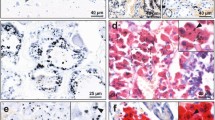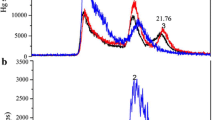Abstract
Concentration of mercury and selenium were analyzed in tissue fractions of human kidney cortex samples from seven autopsy cases. Total mercury content ranged between 0.3–9.0 nmol Hg/g wet wt. Between 27–61% of the total mercury was found in the 105,000g supernatant of the tissue homogenate from six cases. In kidney cortex from the seventh case, a deceased dentist with the highest concentration of mercury, only 3% of the total mercury was found in the 105,000g supernatant and about 88% in a SDS-insoluble fraction. In this fraction the molar ratio between mercury and selenium was close to 1∶1. This study supports results from previous animal studies and indicates that mercury in human kidney cortex could be deposited in forms with different solubility. It could be of importance to speciate different forms of mercury in tissues according to solubility and association to selenium when interpretations of mercury concentrations are made.
Similar content being viewed by others
References
M. Berlin, inHandbook on the Toxicology of Metals, Vol. II, L. Friberg, G. F. Nordberg, and V. Vouk, eds., Elsevier, Amsterdam, pp. 387–445 (1986).
WHO,IPCS, Environmental Health Criteria: 118 Inorganic mercury, World Health Organization, Geneva (1991).
J. Parizek and I. Ostadalova,Experientia,23, 142–143 (1967).
M. Nordberg, B. Trojanowska, and G. F. Nordberg,Environ. Physiol. Biochem. 4, 149–158 (1974).
E. Komsta-Szumska and J. Chmielnicka,Arch. Toxicol. 38, 217–228 (1977).
R. W. Chen, P. D. Whanger, and S. C. Fang,Pharmacol. Res. Commun. 6, 571–579 (1974).
A. Naganuma and N. Imura,Pharmac. Biochem. Behav. 15, 449–454 (1981).
D. H. Groth, L. Settler, and G. Mackay, inEffects and Dose-Response Relationships of Toxic Metals, G. F. Nordberg, ed., Elsevier, Amsterdam, pp. 527–543 (1976).
J. H. Koeman, W. H. M. Peeters, C. H. M. Koudstaal-Hol, P. S. Tijoe, and J. J. M. de Goeij,Nature 245, 385–386 (1973).
C. Leonzio, S. Focardi, and C. Fossi,Sci. Total Environ.,119, 77–84 (1992).
L. Kosta, A. R. Byrne, and V. Zelenko,Nature,254, 238, 239 (1975).
M. Nylander and J. Weiner,Br. J. Ind. Med. 48, 729–734 (1991).
L. Magos,Analyst 96, 847–853 (1971).
B. Lind, L. Friberg, and M. Nylander,J. Trace Elements Exp. Med. 1, 49–56 (1988).
B. Lind, R. Body, and L. Friberg,Fresenius' J. Anal. Chem. 345, 314–317 (1993).
M. Nylander, L. Friberg, and B. Lind,Swed. Dent. J. 11, 179–187 (1987).
I. Drabaek, V. Carlsen, and L. Just,J. Radioanal. Nucl. Chem. Lett. 103, 249–260 (1986).
L. Hansson, J. Pettersson, and Å. Olin,Talanta 34, 829–833 (1987).
M. Nylander, L. Friberg, D. Eggleston, and L. Björkman,Swed. Dent. J. 13, 235–243 (1989).
R. J. Hargreaves, J. G. Evans, I. Janota, L. Magos, and J. B. Cavanagh,Neuropathol. Appl. Neurobiol. 14, 443–452 (1988).
I. Falnoga, I. Kregar, M. Skreblin, M. Tusek-Znidaric, and P. Stegnar,Biol. Trace Element Res.,37, 71–83 (1993).
G. F. Nordberg, M. Nordberg, M. Piscator, and O. Vesterberg,Biochem. J. 125, 491–498 (1972).
R. F. Burk, K. A. Foster, P. M. Greenfield, and K. W. Kiker,Proc. Soc. Exp. Biol. Med. 145, 782–785 (1974).
T. A. Gasiewicz and J. C. Smith,Chem.-Biol. Interactions,23, 171–183 (1978).
O. Wada, N. Yamaguchi, T. Ono, M. Nagahashi, and T. Morimura,Environ. Res. 12, 75–80 (1976).
J. R. Prohaska and H. E. Ganther,Chem.-Biol. Interactions 16, 155–167 (1977).
L. Björkman, S. Langworth, B. Lind, C.-G. Elinder, and M. Nordberg,J. Trace Elem. Electrolytes Health Dis.,7, 157–164 (1993).
L. Björkman, M. Svartengren, and M. Nordberg,Hum. Exp. Toxicol. 11, 341–346 (1992).
J. T. Salonen, R. Salonen, R. Lappeteläinen, P. H. Mäenpää, G. Alfthan, and P. Puska,Br. Med. J. 290, 417–420 (1985).
J. C. Hansen,Med. Hypotheses,25, 45–53 (1988).
Å. Bruce,Annals Clin. Res. 18, 8–12 (1986).
WHO,IPCS, Environmental Health Criteria: 101. Methylmercury, World Health Organization, Geneva (1990).
Author information
Authors and Affiliations
Rights and permissions
About this article
Cite this article
Björkman, L., Palm, B., Nylander, M. et al. Mercury and selenium distribution in human kidney cortex. Biol Trace Elem Res 40, 255–265 (1994). https://doi.org/10.1007/BF02950798
Received:
Accepted:
Issue Date:
DOI: https://doi.org/10.1007/BF02950798




